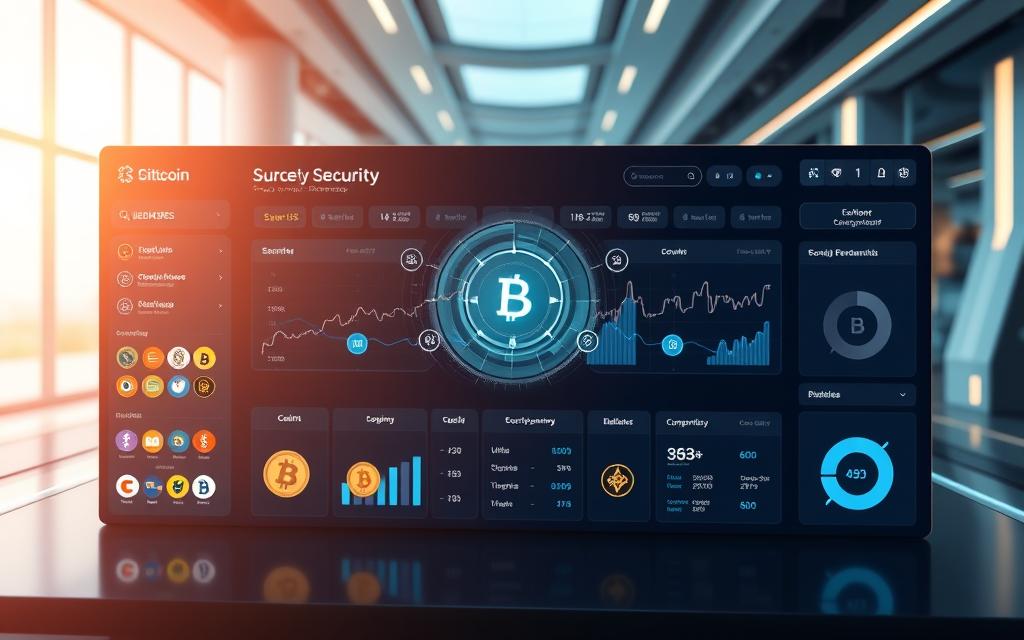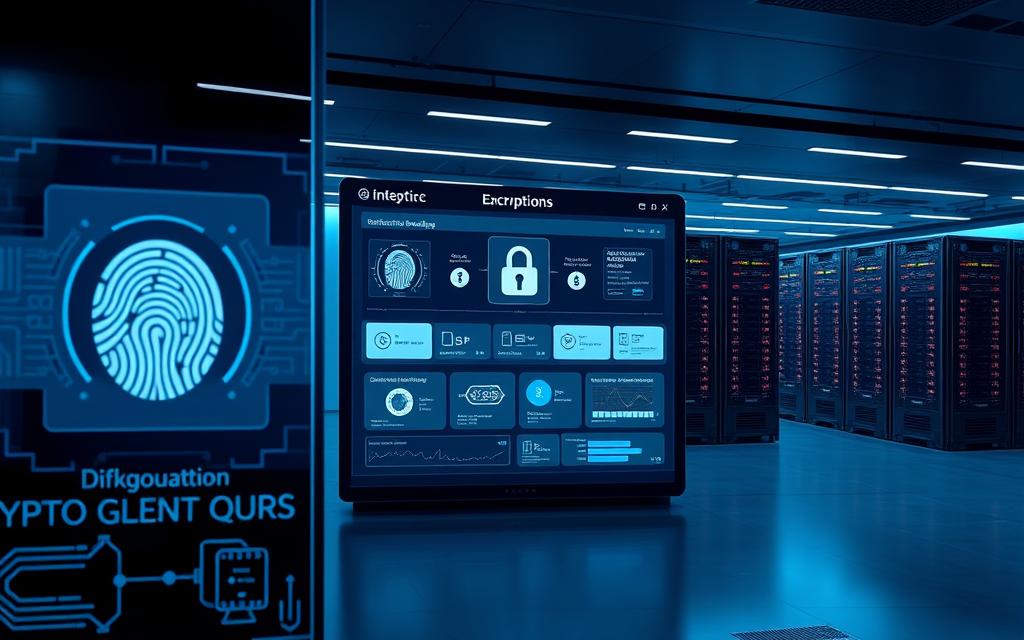Table of Contents
The cryptocurrency market has surged to a $2.4 trillion valuation, making security a top priority. With rapid adoption, investors need clarity on emerging risks and safeguards in 2025.
Regulatory shifts are reshaping the digital currency landscape. Governments worldwide are tightening rules to protect users while fostering innovation in blockchain technology.
New threats like quantum computing challenge current encryption methods. Meanwhile, institutional players like JPMorgan drive adoption, balancing security with scalability.
Decentralization remains key, but 99% of Bitcoin mining pool control raises concerns. Cold storage and advanced cryptography offer solutions as the crypto ecosystem evolves.
Introduction to Cryptocurrencies and Blockchain Technology
Digital currencies have transformed global finance, offering secure and decentralized alternatives to traditional systems. These digital assets rely on advanced cryptography and distributed networks to enable peer-to-peer transactions without intermediaries.
What Is Cryptocurrency?
Cryptocurrency represents a new class of digital money secured through elliptical curve encryption. Unlike bank-issued currency, these assets operate on decentralized networks where users control transactions.
Key characteristics include:
- Cryptographic security using public-private key pairs
- Decentralized verification through node consensus
- Immutable transaction records on distributed ledgers
Projects like XRP demonstrate real-world utility, enabling instant cross-border payments for financial institutions. This contrasts sharply with traditional banking systems that often take days for international transfers.
How Blockchain Ensures Security
The blockchain serves as the foundation for cryptocurrency security. This distributed ledger technology prevents double-spending and maintains transaction integrity through cryptographic hashing.
Security features include:
- Consensus mechanisms requiring network approval for transactions
- Cryptographic linking of blocks making tampering evident
- Decentralized structure eliminating single points of failure
Two primary ledger models exist:
- UTXO (Used in Bitcoin): Tracks unspent transaction outputs
- Account-based (Used in Ethereum): Maintains balance records
For deeper insights into cryptocurrency fundamentals, explore this comprehensive guide on digital currency security.
How Safe Are Cryptocurrencies? Understanding the Basics
Modern crypto security combines advanced mathematics with distributed network protocols. These systems protect digital assets through layered defenses against theft and accidental loss.
Cryptographic Foundations
Blockchain networks use two essential encryption methods:
- SHA-256: Creates irreversible transaction fingerprints
- ECDSA: Verifies ownership through digital signatures
These algorithms make transactions tamper-proof. However, vulnerabilities can emerge during key generation. Weak random number generators have compromised wallets in the past.
| Consensus Type | Security Model | Energy Use |
|---|---|---|
| Proof-of-Work (PoW) | Mining competition | High |
| Proof-of-Stake (PoS) | Staked collateral | Low |
Ethereum’s shift to PoS reduced attack risks by 99%. Validators now stake ETH instead of competing with computing power.
Private Key Protection
An estimated 20% of all Bitcoin remains inaccessible due to lost private keys. These digital passwords control asset ownership.
Best practices include:
- Multi-signature wallets requiring 2/3 approvals
- Metal seed phrase storage resistant to fire/water
- Air-gapped devices for high-value holdings
True decentralization varies by network. Bitcoin has 10 major mining pools while Solana uses 1,500 validators. More nodes generally mean better security.
Types of Cryptocurrencies and Their Security Features
Different digital assets offer unique security approaches tailored to their design. From Bitcoin’s battle-tested network to privacy coins’ advanced cryptography, each solution addresses specific risks.

Bitcoin and Its Security Model
The pioneer cryptocurrency uses an UTXO model that tracks unspent transaction outputs. This system creates transparent audit trails but has scripting limitations for complex operations.
Bitcoin’s proof-of-work consensus requires significant energy. The 21 million supply cap enhances scarcity, while decentralized mining prevents single-entity control. However, concentrated mining pools present potential risks.
Ethereum and Smart Contract Safety
Ethereum’s shift to proof-of-stake reduced energy use by 99%. The platform now requires formal verification for smart contracts, as explained in this security guide.
Key safety measures include:
- Mandatory code audits before deployment
- Bug bounty programs for white-hat hackers
- Upgradable contracts with timelock features
Privacy-Focused Coins
Anonymous transactions use different technologies:
| Coin | Technology | Visibility |
|---|---|---|
| Monero | Ring signatures | Fully private |
| Zcash | zk-SNARKs | Selective disclosure |
| Dash | CoinJoin mixing | Semi-private |
Litecoin’s Mimblewimble implementation shows how older blockchain projects adapt privacy features. These coins face regulatory scrutiny despite their security advantages.
Common Security Risks in Cryptocurrency
Investors face evolving threats as digital assets grow in value. While blockchain technology offers robust security, malicious actors constantly develop new exploits. Understanding these risks helps users protect their holdings.
Phishing and Scams
Phishing remains a top threat, with fake websites and emails mimicking legitimate platforms. Attackers steal login credentials or seed phrases to drain wallets. Common tactics include:
- Fake wallet apps on official stores
- Impersonation of support staff via social media
- Malicious links in airdrop announcements
In 2022, fake ICOs siphoned $300M from investors. Always verify URLs and enable secure trading practices like anti-phishing codes.
Exchange Hacks and Wallet Vulnerabilities
Crypto exchanges lost over $1B to breaches in 2022. Mt. Gox and Coincheck incidents highlight the risks of centralized platforms. Key vulnerabilities include:
- Hot wallet compromises due to poor key management
- Insider threats from employees
- Smart contract bugs in DeFi bridges
Non-custodial wallets reduce exposure, but users must guard against malware. Hardware wallets like Ledger offer offline protection.
51% Attacks and Double-Spending
Smaller blockchains face attacks where attackers control most mining power. They can reverse transactions, enabling double-spending. Costs vary by chain:
| Blockchain | Attack Cost (2025) |
|---|---|
| Ethereum Classic | $500K/day |
| Bitcoin Gold | $200K/day |
Proof-of-Stake networks resist these attacks better than PoW. Dusting attacks—sending traceable micro-transactions—also threaten privacy.
Cryptocurrency Exchanges: Safety Measures and Risks
Proof-of-reserves audits have become industry standards for transparency. Leading platforms now implement multi-layered security to protect user funds during trading. These measures separate trusted cryptocurrency exchanges from vulnerable ones.

Evaluating Exchange Security Models
Custodial platforms like Coinbase manage private keys for users. Non-custodial alternatives such as Uniswap let traders retain control. Key differences include:
- Custodial: Insured deposits but centralized risk
- Non-custodial: Self-managed keys with no recovery options
Binance’s proof-of-reserves system verifies 1:1 asset backing. This cryptographic audit shows real-time holdings without exposing sensitive data.
Advanced Protection Protocols
NYDFS-licensed exchanges must meet strict capital requirements. Coinbase’s $255M insurance covers:
| Coverage Type | Protection Limit |
|---|---|
| Hot wallet breaches | 100% of digital assets |
| Cold storage failure | $150M per incident |
| Employee theft | $5M policy |
Two-factor authentication adds critical login security. Hardware security modules (HSMs) encrypt keys at enterprise-grade exchanges like Kraken.
Withdrawal whitelisting prevents unauthorized transfers. Institutions often use multi-signature wallets requiring 3/5 approvals for large transactions.
Protecting Your Crypto Assets: Best Practices
Safeguarding digital wealth requires proactive measures against evolving threats. Investors must implement layered security strategies to shield their holdings from theft and human error.

Choosing the Right Wallet Solution
Hardware wallets like Ledger Nano X provide offline storage with military-grade encryption. These devices isolate private keys from internet-connected devices, blocking remote attacks.
Software wallets offer convenience but carry higher risks. Mobile and browser extensions remain vulnerable to malware. Key differences include:
- Cold storage: No internet connection (hardware/paper)
- Hot wallets: Always online (mobile/desktop apps)
Institutional investors often use multi-signature configurations. These require 2-of-3 approvals for transactions, preventing single-point failures.
Defending Against Digital Deception
Social engineering attacks account for 85% of crypto thefts. Scammers impersonate support teams or create fake giveaways to steal credentials.
Effective countermeasures include:
- Biometric authentication for wallet access
- Address whitelisting to limit withdrawal destinations
- Transaction simulation tools to preview outcomes
Arkose Labs’ anti-bot solutions help platforms detect fraudulent login attempts. Regular security training teaches users to spot phishing emails and malicious links.
Rotating wallets every six months enhances protection. This practice limits exposure if a single address gets compromised.
Regulatory Landscape for Cryptocurrencies in 2025
2025 marks a turning point for digital asset regulations as global standards emerge. Financial authorities now implement coordinated frameworks to govern cryptocurrency markets while fostering innovation.

U.S. Regulations and Compliance
The SEC classifies most tokens as securities under the Howey Test. New York requires BitLicense approvals, while Wyoming offers crypto-friendly banking charters.
Key U.S. requirements include:
- IRS Form 8949 for reporting crypto transactions
- OFAC sanctions screening for wallet addresses
- FinCEN registration for money service businesses
“The Travel Rule now applies to all transfers exceeding $3,000, creating new compliance burdens for exchanges.”
Global Regulatory Trends
Europe’s MiCA framework imposes strict capital requirements for stablecoin issuers. Japan’s FSA mandates exchange licensing, while Singapore uses sandbox testing.
| Jurisdiction | Key Regulation | Effective Date |
|---|---|---|
| European Union | MiCA Capital Buffers | June 2025 |
| United Kingdom | Financial Promotions Rule | January 2025 |
| United Arab Emirates | Virtual Assets Law | Q3 2025 |
Central bank digital currencies (CBDCs) gain traction, with 18 nations piloting programs. These government-backed tokens may reshape crypto adoption patterns worldwide.
The Role of Smart Contracts in Enhancing Security
Self-executing agreements on blockchain networks redefine digital security standards. These programmable contracts automate transactions when preset conditions meet, reducing human error. However, their irreversible nature demands flawless code implementation.
How Smart Contracts Work
Turing-complete platforms like Ethereum enable complex logic execution. Contracts deploy to distributed ledgers where they run exactly as written. Key characteristics include:
- Deterministic outcomes based on input data
- Transparent execution visible to all network participants
- Gas fees that prevent infinite loops
The Ethereum Virtual Machine (EVM) processes most contracts today. Emerging alternatives like WASM promise better security through:
| Feature | EVM | WASM |
|---|---|---|
| Execution Speed | Slow | Fast |
| Memory Safety | Limited | Enhanced |
| Language Support | Solidity | Multiple |
Common Vulnerabilities and Mitigation
Over $2B was lost to DeFi hacks in 2022, per CertiK reports. The DAO attack demonstrated how reentrancy exploits work:
- Attacker calls vulnerable function
- Contract processes withdrawal before updating balance
- Malicious callback repeats the process
Prevention methods include:
- Checks-effects-interactions pattern
- Formal verification tools like Certora
- Time locks for critical functions
“Audited contracts show 63% fewer vulnerabilities than unaudited ones.”
Oracle manipulation remains another major risk. Chainlink’s decentralized data feeds help prevent price feed attacks. Leading platforms now run continuous bug bounty programs, with rewards exceeding $250,000 for critical flaws.
Future of Cryptocurrency Security: Trends to Watch
Quantum-resistant solutions are becoming essential in modern digital asset security. As threats evolve, the blockchain industry adapts with groundbreaking protection methods. These advancements aim to safeguard transactions against both current and emerging risks.
Quantum Computing Challenges
Shor’s algorithm threatens current encryption by potentially breaking RSA and ECC systems. Quantum computers could factor large numbers exponentially faster than classical machines. This puts traditional crypto security at risk within the next decade.
NIST has standardized four post-quantum algorithms:
- CRYSTALS-Kyber (key encapsulation)
- CRYSTALS-Dilithium (digital signatures)
- SPHINCS+ (hash-based signatures)
- Falcon (compact signatures)
“Lattice-based cryptography offers the most promising defense against quantum attacks due to its mathematical complexity.”
Next-Generation Encryption
Hybrid systems now combine classical and quantum-resistant encryption technologies. These solutions maintain compatibility while future-proofing networks. Zero-knowledge proofs enhance privacy without compromising security.
Key advancements include:
| Technology | Application | Adoption Rate |
|---|---|---|
| Multi-party computation | Wallet security | 35% of exchanges |
| Homomorphic encryption | Private smart contracts | Early stage |
| Decentralized identity | KYC solutions | 12% of platforms |
AI-driven threat detection analyzes patterns across blockchain networks. These systems identify suspicious behavior in real-time, reducing response times from hours to seconds. As attacks grow more sophisticated, defense mechanisms must evolve equally fast.
Investing in Cryptocurrencies: Balancing Risk and Reward
Strategic investing in digital assets demands careful risk assessment and mitigation. The crypto market’s extreme fluctuations require specialized approaches to capital preservation. Investors must weigh potential rewards against unique vulnerabilities in this emerging asset class.
Assessing Market Volatility
Bitcoin’s history includes 60% drawdowns during market corrections. These swings exceed traditional market volatility benchmarks. Key metrics for evaluation include:
- 30-day realized volatility (currently 85% for BTC)
- Correlation matrices showing asset relationships
- Liquidation heatmaps for leverage positions
Grayscale’s investment products demonstrate institutional adaptation strategies. Their Bitcoin Trust (GBTC) provides exposure without direct ownership risks. Futures-based ETFs offer alternative structures with different risk profiles.
| Asset | 90-Day Volatility | Correlation to S&P 500 |
|---|---|---|
| Bitcoin | 78% | 0.42 |
| Ethereum | 92% | 0.38 |
| Stablecoins | 3% | -0.11 |
Diversification Strategies
Effective diversification strategies reduce concentration risk in crypto portfolios. Allocate across:
- Market caps (large/mid/small)
- Use cases (smart contracts, storage, payments)
- Consensus mechanisms (PoW, PoS, etc.)
Dollar-cost averaging smooths entry points during volatility. Staking provides yield opportunities (current average: 5-12% APY). Index funds like Bitwise 10 offer broad market exposure.
“Portfolios with 5-15% assets allocation show optimal risk-adjusted returns in backtesting.”
Stress testing helps prepare for black swan events. Scenario analysis should include exchange failures and regulatory shocks. Cold storage solutions protect against systemic risks in custodial platforms.
Conclusion
Blockchain security continues evolving as new threats emerge in 2025. Investors must prioritize cold storage and multi-signature wallets to safeguard cryptocurrency holdings. Regulatory frameworks now offer clearer guidelines, reducing uncertainty for institutional investments.
Quantum-resistant upgrades and AI-driven monitoring enhance long-term protection. Education remains critical—users should stay updated on phishing tactics and smart contract risks.
The crypto ecosystem balances innovation with robust security. As adoption grows, proactive measures ensure cryptocurrency remains a viable asset class for the future.
FAQ
What makes blockchain technology secure?
Blockchain uses cryptography and decentralization to protect transactions. Each block links to the previous one, making tampering nearly impossible without altering the entire chain.
Why are private keys important for crypto security?
Private keys grant access to digital assets. Losing them means losing funds, while exposure can lead to theft. Always store them offline in hardware wallets for maximum protection.
How do cryptocurrency exchanges ensure user safety?
Reputable platforms like Coinbase and Binance use two-factor authentication (2FA), cold storage for funds, and regular audits to minimize risks of hacks.
What are the biggest threats to crypto investors?
Phishing scams, exchange breaches, and smart contract exploits pose significant risks. Research projects thoroughly and avoid sharing sensitive data.
Are privacy-focused coins like Monero safer than Bitcoin?
Privacy coins enhance anonymity but face regulatory scrutiny. Their security depends on the underlying technology, not just transaction masking.
How can I protect my digital assets from theft?
Use hardware wallets for long-term storage, enable 2FA, and avoid clicking suspicious links. Diversify holdings across multiple secure wallets.
Will quantum computing break cryptocurrency encryption?
Future quantum computers may threaten current encryption, but developers are already working on quantum-resistant blockchain solutions.
What role do smart contracts play in security?
They automate transactions without intermediaries, but coding flaws can lead to exploits. Audits by firms like CertiK help identify vulnerabilities.
How do regulations impact crypto safety?
Compliance frameworks like the SEC’s rules aim to reduce fraud while maintaining innovation. Licensed exchanges often provide better investor protections.
Is crypto mining still profitable and secure?
Mining profitability depends on hardware costs and coin value. Pool mining reduces individual risk but requires trusting third-party operators.









